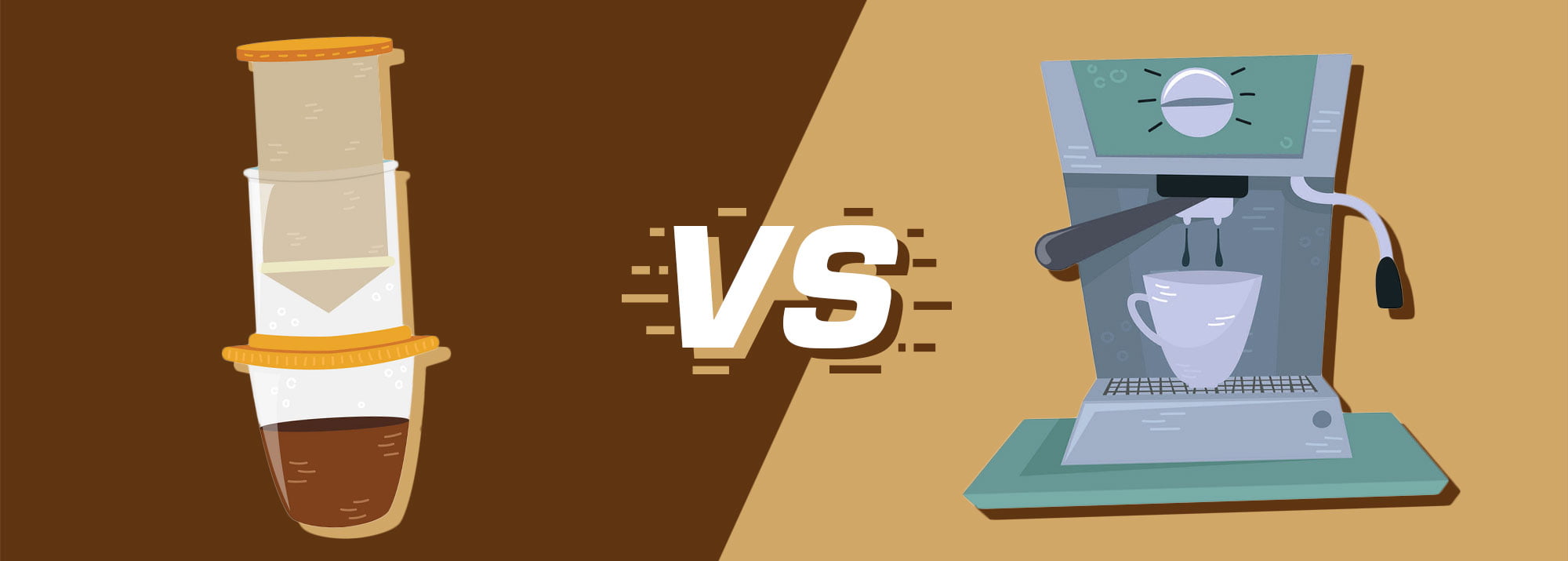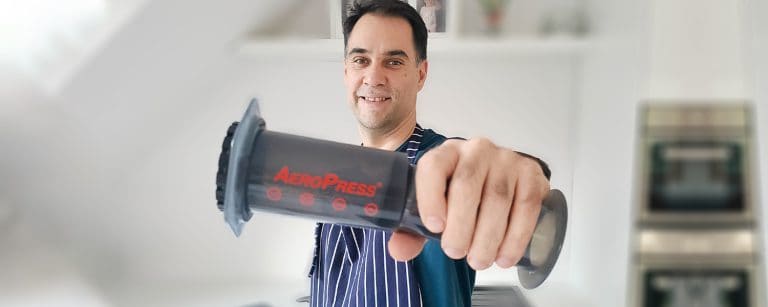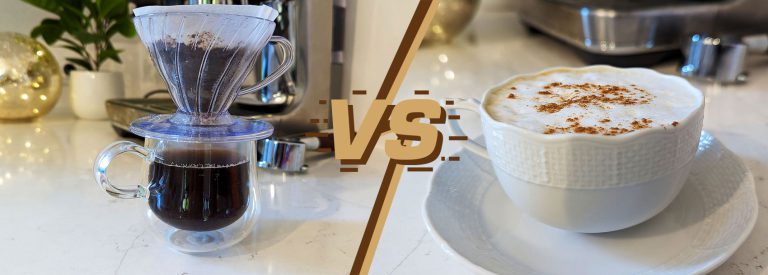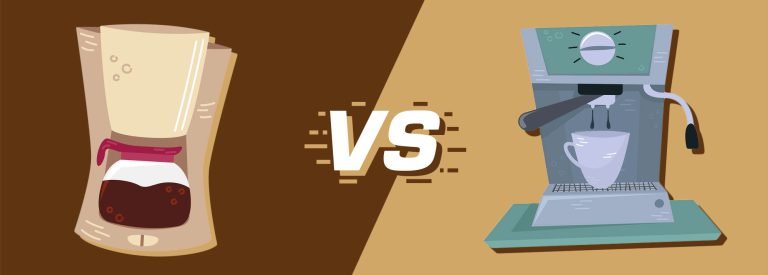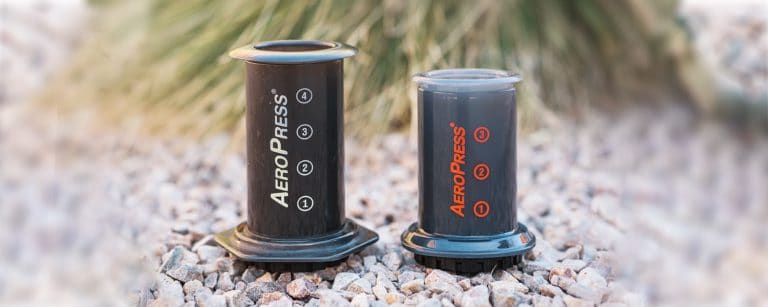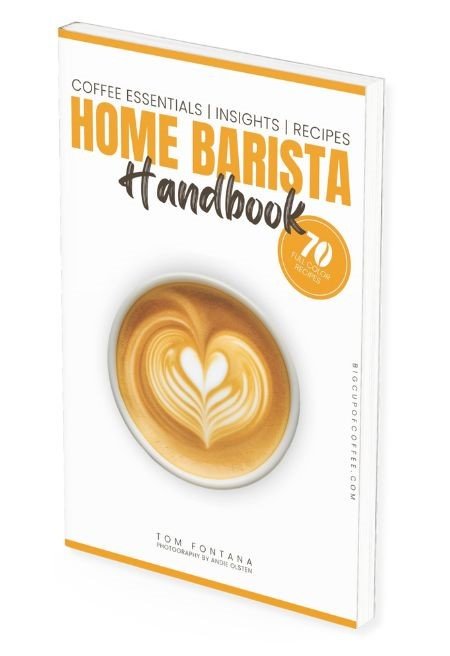AeroPress vs Espresso – The Barista Breakdown: Which is Better?
When making coffee in the morning, I always find myself torn between using my trusty AeroPress or my espresso machine (Breville Barista Pro right now).
Both are wildly popular brewing methods in the caffeine world, but which one is better?
In this article, I’ll be taking you through a comparison of the two, weighing up their pros and cons to help you decide which one reigns supreme. So sit back, grab your favorite mug, and let’s get into it.
Comparing AeroPress & Espresso
So, which is better, the AeroPress or the espresso? It may sound cliché, but the answer depends on what you’re looking for in your coffee.
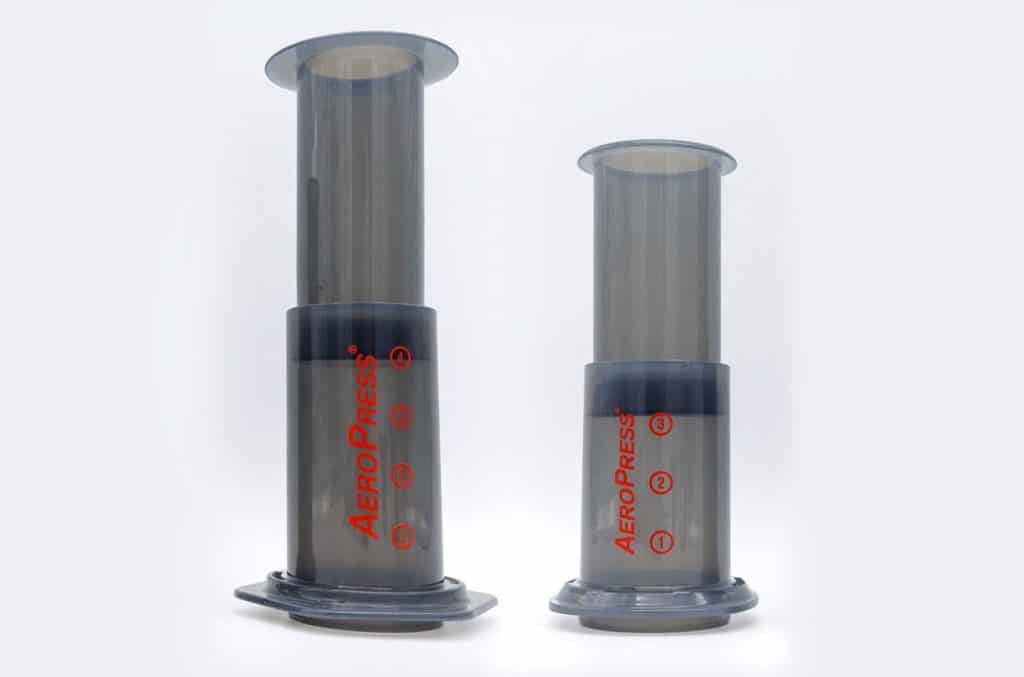

AeroPress is one of the easiest and most efficient ways to make a delicious cup of coffee at home. Unlike other coffee brewing methods, the AeroPress utilizes its piston design to exert pressure on hot water and ground coffee. This unique process creates a smooth, rich brew with minimal bitterness in just minutes.
On the other hand, Espresso has become synonymous with high-quality coffee worldwide. The espresso-making process involves using finely-ground coffee beans and passing hot pressurized water through them at 9 bars of pressure. This intense pressure extracts all the flavors and oils from the beans, resulting in an incredibly strong yet balanced flavor profile filled with crema – a layer of foam created by emulsified oils that sit atop every shot.
Here are the factors to consider when picking between the two brewing methods, followed by a detailed comparison of each feature.
| Features | AeroPress | Espresso |
|---|---|---|
| Taste & Flavor | Rich, full-flavored, low acidity | Strong, bold flavor with crema |
| Strength | Can achieve similar strength as espresso, but can also make much lighter coffee | Bolder and stronger |
| Ease of Use | Simple and straightforward brewing process | Requires practice and skill |
| Brewing Speed | Total brewing time around 3-4 minutes | Takes only 2 minutes |
| Versatility | Highly versatile with customizable features | Precise brewing method with limited versatility |
| Durability & Portability | Ultra-durable, lightweight, and compact | Varies depending on the model, less portable |
| Sustainability | Uses paper filters, can be composted or recycled | Less energy-efficient, no paper filters |
| Cost | Affordable, typically around $30-$40 | Can range from $100 to several thousand dollars |
Detailed Comparison Between the AeroPress & Espresso
Here’s a closer look at the factors that set AeroPress and espresso apart from each other.
Taste, Flavor, & Strength
The AeroPress and Espresso have unique qualities when they hit the palate. For starters, the AeroPress produces a rich and full-flavored cup of coffee with low acidity. However, what makes this brewing method special is its versatility in achieving different taste profiles. Whether you prefer an espresso-style shot or a longer, more diluted cup, the AeroPress can deliver.
On the other hand, Espresso is known for its strong concentration of caffeine and bold flavor profile. No other brewing method can reproduce the beautiful crema on top due to the high pressure it uses. And since it is a short, strong shot, espresso is often blended with milk and other sweeteners afterward to create milk and espresso drinks like these.
Still, many drinkers prefer pure espresso served with sparkling water, which helps in cleansing your palate so you can appreciate your espresso shot better.
In terms of strength, the Espresso is definitely bolder and stronger. While an AeroPress can reach a roughly similar level of strength as espresso with this recipe, Espresso’s concentration is only achievable through its specific, high-pressure brewing process.
Personally, I lean towards the espresso when it comes to taste and strength. It has an unparalleled flavor that is consistent and easy to tame with the addition of other ingredients.
Ease of Use
How easy are these brewers to use, you ask? In this regard, the AeroPress takes the cake over the espresso.
With an AeroPress, you won’t need much skill or practice to brew a great cup of coffee, just a good manual burr grinder. The brewing process is simple, straightforward, and not messy:
- Measure out your medium-fine ground coffee,
- add the filter and
- hot water (175°F to 205°F),
- let it steep for a few minutes based on your recipe,
- then press down on the plunger to extract your coffee.
On the other hand, mastering espresso requires significant practice and patience. Dialing in an espresso shot can be challenging since every element affects its quality.
- Pick the proper roast level,
- get the right fine grind size,
- tamp it in the portafilter,
- keep the temperature between 190°F to 200°F, and
- extract using the correct pressure.
Furthermore, getting a perfect extraction can take several tries before achieving consistency.
So if you’re looking for simpler brewing, the AeroPress is your best bet. It’s effortless and easy to brew amazing coffee without spending too much time perfecting the process. On the other hand, mastering espresso requires significant practice and skill that can really be rewarding.
Brewing Speed
While the AeroPress is easier to use, the espresso wins in brewing speed once you’ve mastered it.
The total prep time for the AeroPress is around 3-4 minutes whereas the espresso takes only 2 minutes, which includes grinding, brewing, and cleaning. While there are recipes available that can reduce the brewing time of AeroPress to as little as 30 seconds, this varies depending on the recipe you choose to follow.
Cleaning up after making coffee with the AeroPress is super easy though. You simply have to dispose of the grinds, and rinse the plunger and chamber in warm water.
A home espresso machine may take a little longer to clean since you have to rinse out the portafilter and basket used for holding ground coffee beans and if applicable, wipe and purge the steam wand.
Keep in mind that espresso machines also need occasional deep cleaning, which really takes up time. I clean my home espresso machine every weekend, it takes about 7-8 minutes, so it’s not the end of the world though.
Versatility
Versatility is crucial for us coffee lovers because it allows us to satisfy our subjective tastes. Sometimes I’m in the mood for something lighter, and sometimes for a coffee with more body and strength.
When comparing Aeropress and espresso, it’s evident that the former offers a higher level of versatility due to its customizable features.
With the ability to control almost every aspect of brewing, such as water temperature, grind size, brewing time, and pressure, you can create a cup that perfectly suits your taste buds. This is why outstanding recipes are annually showcased at AeroPress championships.
As for the espresso, it is a precise brewing method that has little room for versatility, with adjustable factors that include grind size, dosage, distribution, tamping pressure, water temperature, and extraction time. You can further customize the shot by adding milk or water in various ratios to achieve different recipes such as:
When deciding between these two methods based on capacity, it’s vital to remember that they were made for different purposes. The standard AeroPress can brew up to 10 oz (290 ml) of coffee, and the slightly smaller AeroPress Go can make 8oz (230 ml) at a time.
On the other hand, espresso is designed to produce one to two shots of coffee, with each shot being only one ounce. This means that if you’re looking for flexibility in terms of producing larger volumes of coffee, then the AeroPress would be your best bet.
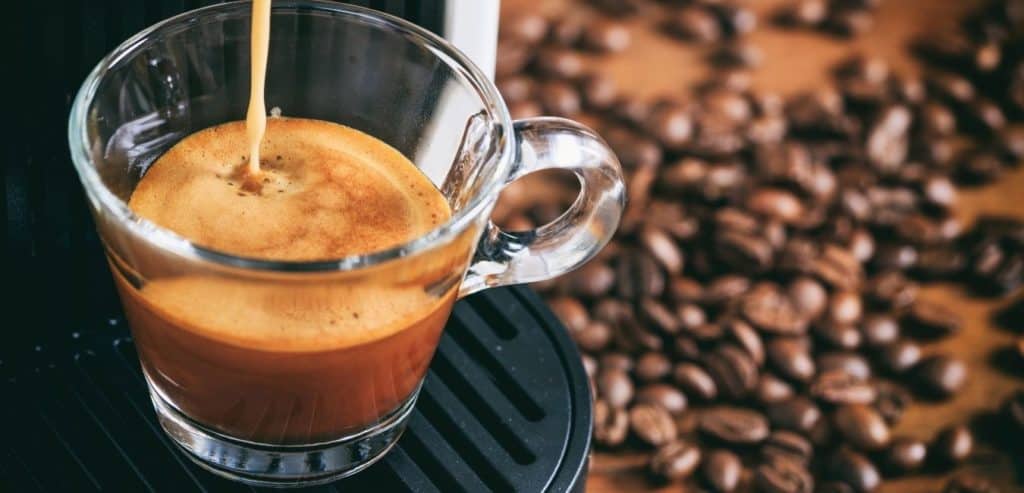
Durability and Portability
Comparing the durability and portability of the AeroPress and the espresso machine can be quite tricky because they’re made for different purposes. The espresso machine offers various material options -from plastic to heavy-duty steel- and is meant to stay in one place, while the AeroPress is a manual brewer made portable.
An AeroPress is constructed with a high-quality plastic material that makes it ultra-durable, plus its lightweight and compact size makes it ideal for use while traveling.
On the other hand, espresso machines vary in size, materials, and overall build quality. Commercial-grade models tend to be heavy-duty but also very large and cumbersome, not exactly an option if you’re always on the go. Smaller home models can be portable but I don’t recommend bringing them along with you since they’re not designed that way.
As someone who is often traveling, I really like using my trusty AeroPress. I can easily squeeze it into my backpack without worrying about any damage and I can easily set it up to brew my favorite cup of coffee anywhere I have access to hot water.
Sustainability
Sustainability is a crucial factor to consider in every aspect of our lives, and coffee is no exception. When comparing AeroPress and Espresso from a sustainability standpoint, there are several factors to explore.
Manual brewers like the AeroPress consume less energy, which already puts the espresso machine at a disadvantage. Some espresso machines even take minutes to warm up, which is a real waste of energy, if you’re just going to pull a single shot in the morning. (This is one of the reasons I love the ThermoJet heat-up system on some Breville espresso makers, they heat up in 3 seconds).
There are manual espresso brewers, like the Flair models, but they take even more time and skill to perfect a cup.
However, the AeroPress uses paper filters while the espresso machine doesn’t. While these paper filters can be recycled or composted after use, they still contribute to waste production. As an alternative though, you can use reusable metal or cloth filters.
Lastly, the plastic construction of the AeroPress is not ideal for sustainability reasons as plastics take a long time to decompose and release harmful chemicals into the soil. Espresso machines may also have plastic bodies, but you have the option to choose the more durable, albeit pricier, steel models. But in all cases, and espresso machine will leave a larger carbon footprint than an Aeropress.
It is essential to remember that every little choice we make toward sustainability counts, so let us all do our part by making our cups eco-friendly by using responsible methods, choosing environmentally-friendly coffee, and recycling waste such as used coffee grounds.
Cost
When it comes to cost, the AeroPress and espresso couldn’t be more different. The AeroPress is a bargain compared to the high-end prices of home espresso machines. You can get your hands on an AeroPress for as little as $30 to $40, depending on where you buy it.
However, don’t forget that there may be additional costs involved with using an AeroPress. Replacement paper filters are needed whenever you make coffee, and these can set you back around $0.02 per filter in 2025. This isn’t too much of a financial burden, but it’s worth bearing in mind.
As for home espresso machines, they can range from around $100 to several thousand dollars depending on quality and features. Of course, if you’re willing to spend big bucks then you’ll undoubtedly get top-tier results – but not everyone can justify such a hefty expense.
The AeroPress is obviously the more affordable option. It’s perfect for coffee lovers who want to enjoy quality brews without breaking the bank. But for people who want to imitate cafe-level drinks, the espresso machine might just be worth the investment.
AeroPress and Espresso – Weighing the Pros & Cons
Now that we’ve gotten a closer look at the features of each brewing method, here’s a quick overview of the pros and cons of AeroPress and espresso so you can finally decide which one is for you:
| Brewing Method | Pros | Cons |
|---|---|---|
| AeroPress | – Highly portable – Versatile – Produces smooth and consistent coffee – Low acidity – Fast and easy to use and clean | – Limited capacity – The plastic body is not eco-friendly |
| Espresso | – Produces highly-concentrated coffee with crema on top – Very fast to produce a shot – Can be used for numerous recipes | – The espresso machine is not portable – Generally expensive – Requires finely ground coffee beans – Using the espresso requires expertise |
You can also check out how AeroPress compares to other brewing methods such as:
Meanwhile, here’s how espresso fares against other brewers:
Conclusion
After comparing AeroPress and Espresso brewing options, it’s clear that both have their own advantages and drawbacks.
- The AeroPress is highly portable, versatile, and produces smooth and consistent coffee with low acidity but it’s not too eco-friendly;
- While an espresso machine produces highly-concentrated coffee with crema on top in a matter of seconds, but it often comes with a heavy price, literally. It is also not an eco-friendly option.
While portability and convenience are really important to me, the coffee that my espresso machine can make really outweighs these factors that the AeroPress aced in. Pulling perfect espresso shots and whipping up different recipes that can compete with my go-to cafes is really satisfying.
How about you, which one do you prefer? I’d love to know your thoughts so feel free to share them in the comments below.

